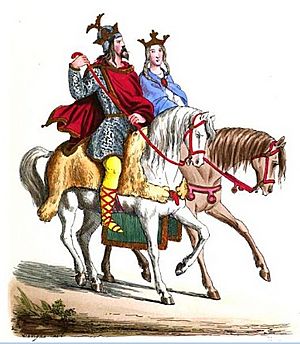Judith, Countess of Flanders facts for kids
Judith of Flanders (also known as Judith of the Franks) was an important member of the Frankish royal family. Born around 844, she became Queen of Wessex twice. Later, through her third marriage, she became the Countess of Flanders.
Contents
Early Life and First Marriage
Judith was the oldest daughter of Charles the Bald, who was both the King of the Franks and a Holy Roman Emperor. Her mother was Ermentrude of Orléans. Judith was born around 844. She was named after her grandmother, Judith of Bavaria, and was said to have inherited her strong personality.
In 855, Æthelwulf of Wessex, the King of Wessex (a kingdom in England), traveled to Rome. On his way back in 856, he visited the court of Emperor Charles the Bald. In July, King Æthelwulf and Judith became engaged. At this time, Judith was only about 12 or 13 years old.
Becoming Queen of Wessex
On October 1, 856, Judith and King Æthelwulf were married in Verberie, northern France. This marriage was a way for their kingdoms to become allies. Both kings were facing attacks from Vikings, and they hoped to work together.
Emperor Charles insisted that his daughter, Judith, be crowned as a proper queen. He wanted her position to be very clear in England. During her coronation, she was anointed with holy oil. This special ceremony was usually only done for bishops and kings.
Before Judith, the wives of kings in Wessex were not called "queens." They were simply known as the king's wife. So, when King Æthelwulf asked Judith to sit beside him as queen, it caused some discussion among his people. There were old beliefs in Wessex about the dangers of having a queen. However, the king's order was followed without any problems from his nobles.
Judith did not have any children with King Æthelwulf. He died in 858.
Second Marriage and Widowhood
After King Æthelwulf died, his son, Æthelbald, became king. Æthelbald then married Judith, who was his stepmother. This marriage was seen as very unusual by many people, including a writer named Asser. King Æthelbald died two and a half years later, leaving Judith a widow for the second time.
Countess of Flanders
After being widowed twice, Judith returned to France. Her father, King Charles, kept her closely guarded at his castle in Senlis. He wanted to find her a new husband quietly.
However, a man named Baldwin, who was already a count, met Judith. In early 862, Baldwin either took Judith away or convinced her to run off with him. It seems she helped him by slipping out of the castle dressed as a peasant girl. Her brother, Louis the Stammerer, also helped them.
When her father found out, he was very angry with both Baldwin and Louis. Baldwin and Judith fled to the court of Lothair II, the king of Lorraine, who was Judith's cousin. They married around 862.
King Charles was so angry that he had his bishops declare the couple "excommunicated." This meant they were forbidden from taking part in church services. He also demanded that his nephew, King Lothair, send Baldwin and Judith back to him.
At this point, Baldwin and Judith wisely traveled to Rome. They asked Pope Nicholas I to approve their marriage and lift the excommunication. Baldwin also made it clear that if his marriage was not allowed, he might join the Vikings, who were a constant threat in northern France. Baldwin was important for fighting the Vikings, so the Pope decided their marriage was valid. He also had the bishops remove their excommunication.
King Charles the Bald was forced to accept Baldwin as his son-in-law. Through this marriage, Judith became the first Countess of Flanders. Baldwin was given control over Flanders and became known as the "Forestier" (a type of count) of Flanders. He protected the region from Vikings for the next fifteen years.
Judith was last known to be alive in 870. Baldwin died in 879.
Judith's children and later family members, including the counts of Flanders and Boulogne, were able to trace their family line back to the famous emperor Charlemagne because of her. She was also an ancestor of Matilda of Flanders, who married William the Conqueror and became Queen of England. This means Judith is an ancestor of many later English monarchs.
Family
- With her first husband, King Æthelwulf of Wessex, Judith had no children.
- With her second husband, King Æthelbald of Wessex, Judith had no children.
- With her third husband, Baldwin I, Count of Flanders, Judith's children included:
- Baldwin II, Count of Flanders (born around 865, died 918). He became count after his father.
- Raoul (also known as Rodulf) (died 896), who was the Count of Cambrai.
- Guinidilda, who married Wifredo I, the Count of Barcelona.


